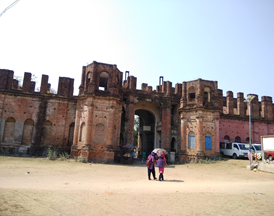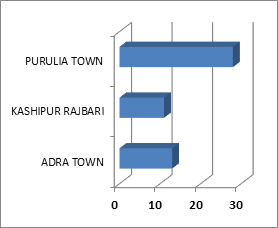


Documentation of several drought tolerance Angiosperms associated with walls in Purulia District, West Bengal
Sujit Kumar Mandal1*, Suparna Mondal2
1 Assistant Professor, Taxonomy of Angiosperms and Biosystematics Laboratory, Department of Botany, Sidho Kanho Birsha University, Sainik School, Purulia-723104, India.
2 Taxonomy of Angiosperms and Biosystematics Laboratory, Department of Botany, Sidho Kanho Birsha University, Sainik School, Purulia-723104, India.
Abstract
This study was conducted to analyze the drought tolerance angiosperms associated with walls in Purulia District, West Bengal. A total of 40 vascular plants were recorded. The angiosperms were represented by 38 genera under 25 different families. Only two species were represented by Pteridophytes viz. Dryopteris filix-mas and Pteris vittata. Asteraceae, Amaranthaceae, and Euphorbiaceae were dominant families during the survey period associated with walls in Purulia District.
Keywords: Documentation, Drought Tolerance, Angiosperms, Walls, Purulia District
Wall, one of the most distinct man-made constructions, is an extreme environment in many respects, such as the available room for settlement, the hardness and the alkalinity of the substratum, the scarcity of soil and humus, the inclination, the temperature and the humidity (Segal, 1969). Thus, being a peculiar habitat, which is suitable for only a limited number of taxa, walls are the subject of an increasing number of publications. In the frame of a wider research concerning the urban and suburban flora of Purulia District, the old fortification walls of the city were studied (Lagiou et al., 1998).
Several scientists also took part in describing the importance of walls as modified cliff-like habitats in urban and semi-urban localities in different countries (Gilbert, 1989; Gilbert, 1992; Larson et al., 2009; Crowe, 1979; Kent et al., 1999; Hill et al., 2002; Lundholm and Marlin, 2006; Francis, 2011; Singh, 2011; Singh and Singh, 2014; Shimwell, 2009; Altay et al., 2010). Different plant groups such as Angiosperms, some Bryophytes and Pteridophytes were frequently distributed on old walls with ecological importance in different environmental conditions like high temperature, hot climate, scarcity of water and humus, extreme pollution by vehicles on roadsides, etc.
Drought is a natural event arising due to extreme temperature, deficiency of precipitation, scarcity of water, global warming, etc (Sharafi et al., 2019; Mirzaee et al., 2018). Drought conditions make it unfavorable for plants and vegetation cover to survive (Fahri Saadi, 2019). Under drought conditions, the vascular plants have inherent dormancy mechanisms that protect their seeds, spores, etc. from germination into such adverse environments (Gul & Kausar, 2019). In this context, the present work was undertaken as research work for documentation of vascular plant species associated with walls in Purulia District.
To carry out the work on drought tolerance Angiosperms associated with the stone and bricks wall in Purulia District, West Bengal, at first, the study area was selected and divided into different localities in different blocks for prevalence percentage of Angiospermic plants and their systematic study. To study the floristic diversity in different selected areas, the frequent visits were conducted to the study area in different localities, so that the taxonomic study of “Documentation of several drought tolerance angiosperms associated with walls in Purulia District, West Bengal ” could be performed.
A general survey was carried out from January 2019 to May 2019 and different habits of plant vegetation such as herbs, shrubs, and trees were observed. During this period (at the end of Post- monsoon and Pre-monsoon) the temperature of study sites was very high. Because Purulia is a drought-prone district of West Bengal. During Pre-monsoon Season, some of the sources of water become dry in Purulia District. Purulia district is considered as dry as well as a backward region of West Bengal where rainfall is considered as a limiting factor for the successful growth of agriculture (Asutosh, 2019). The general associations of plants were observed in all the unprotected areas. Apart from the study of vegetation, plant species were collected, Herbarium sheets were prepared and identified with the help of pertaining literature (Prain, 1963; Roy and Mukherjee, 2011; Mandal and Mukherjee, 2016; Dey, and Das, 2017; Paul, 2018; Pal et al., 2000). During the survey period we visited different pally of Purulia Town such as Sufal pally, Bal Bharati Lane, Vivekananda Pally, BSNL office’s Lane, Near IDBI Bank Lane, Ashu Sahish Lane along with Adra Town such as South Eastern Railway Colony, Station Road, and Kashipur Rajbari in Purulia District and the vegetation of drought-tolerant species in walls were recorded. Herbarium specimens were preserved in the proposed Herbarium, Sidho Kanho Birsha University, Purulia for further studies.
Adra Town
A small rural settlement elevated to a town by the British setting up a large Railway Junction in 1903. Some colonies were built for the residential purpose of the Railway officers of the British. Adra Town includes Beniasole, Palashkola, Jhariadih, Panchudanga, Laldanga, Daulatpur, Arabinda Pally, and South Eastern Railway colonies.
Kashipur Rajbari
The structure of Kashipur Raj Bari is in the colonial style and design incorporating the use of materials like red brick, stone slabs, concrete, and wood. This is familiar as a heritage site of Purulia District. It is situated along a similar line between 23 ° 26’ 2.84 “ N latitude and 86 40‘ 4.34 “ E longitude at Kashipur town. The distance is about 25 km from Purulia and seven kilometers from Adra. Maharaja Neelmoni Singh Deo was the owner of this property. Maharaja Bhuvaneswari Prasad Singh Deo was the last owner of Kashipur Rajbari (Fig. 1).

Fig. 1: A view of Kashipur Rajbari
Purulia Town
Purulia is located between 22.60 ° and 23.50 ° north latitudes and 85.75 ° and 86.65° east longitudes. The area of the district is about 6259 Sq. km. This district is bordered on the east by Bankura, Paschim Medinipur districts, on the north by Burdwan district of West Bengal and Dhanbad district of Jharkhand, on the west by Bokaro and Ranchi districts of Jharkhand and on the south by West Singhbhum and East Singhbhum districts of Jharkhand (Mandal and Mukherjee, 2016) (Fig. 2).
Fig. 2: A political map of Purulia District, West Bengal.
Purulia is characterized by high evaporation and low precipitation. It is also an undulating part of Chota Nagpur Plateau. Temperature is average in summer and low in winter, which ranges from 2 °C in winter to 35 °C in summer. Average annual rainfall varies from 1100 to 1500 mm.
Table 1: An account of the prevalence of plant Species in different walls.
|
Sl. No. |
Name of the plant |
Family |
Attendance in study sites |
Prevalence (%) |
Availability |
||
|
AT |
KR |
PT |
|||||
|
1 |
Acalypha indica L. |
Euphorbiaceae |
|
|
+ |
33.33 |
Less common |
|
2 |
Aerva lanata (L.) Juss ex.Schult. |
Amaranthaceae |
|
|
+ |
33.33 |
Less common |
|
3 |
Alternanthera sessilis (L.) R. Br. ex Dc. |
Amaranthaceae |
|
|
+ |
33.33 |
Less common |
|
4 |
Amaranthus viridis L. |
Amaranthaceae |
|
+ |
+ |
66.66 |
Common |
|
5 |
Ammannia baccifera L. |
Lythraceae |
|
|
+ |
33.33 |
Less common |
|
6 |
Anisomeles indica (L.) Kuntze |
Lamiaceae |
+ |
|
|
33.33 |
Less common |
|
7 |
Antigonon leptopus Hook & Arn. |
Polygonaceae |
+ |
|
|
33.33 |
Less common |
|
8 |
Blumea lacera Dc. |
Asteraceae |
|
|
+ |
33.33 |
Less common |
|
9 |
Boerhaavia repens L. |
Nyctaginaceae |
|
+ |
|
33.33 |
Less common |
|
10 |
Calotropis procera (Ait) R. Br. |
Asclepiadaceae |
|
+ |
|
33.33 |
Less common |
|
11 |
Catharanthus roseus (L.) G. Don |
Apocynaceae |
|
+ |
|
33.33 |
Less common |
|
12 |
Cleome rutidosperma Dc. |
Cleomaceae |
|
|
+ |
33.33 |
Less common |
|
13 |
Cleome viscosa L. |
Cleomaceae |
|
|
+ |
33.33 |
Less common |
|
14 |
Commelina benghalensis L. |
Commelinaceae |
+ |
|
|
33.33 |
Less common |
|
15 |
Croton bonplandianus Baill. |
Euphobiaceae |
+ |
+ |
+ |
100 |
Common |
|
16 |
Dryopteris filix-mas (L.) Scholt. |
Dryopteridaceae |
+ |
|
|
33.33 |
Less common |
|
17 |
Eclipta prostrata (L.) L. |
Asteraceae |
+ |
+ |
+ |
100 |
Common |
|
18 |
Eragrostis tenella (L.) P. Beauv. |
Poaceae |
|
+ |
|
33.33 |
Less common |
|
19 |
Euphorbia hirta L. |
Euphorbiaceae |
+ |
|
+ |
66.66 |
Common |
|
20 |
Evolvulus nummularius (L.) L. |
Convolvulaceae |
|
|
+ |
33.33 |
Less common |
|
21 |
Glinus oppositifolius (L.) Aug. |
Molluginaceae |
+ |
|
+ |
66.66 |
Common |
|
22 |
Gomphrena celosioides Mart. |
Amaranthaceae |
+ |
|
|
33.33 |
Less common |
|
23 |
Kyllinga monocephala Rott. |
Cyperaceae |
|
|
+ |
33.33 |
Less common |
|
24 |
Lantana camara L. |
Verbenaceae |
|
+ |
|
33.33 |
Less common |
|
25 |
Lindenbergia indica (L.) Vatke |
Scrophulariaceae |
|
|
+ |
33.33 |
Less common |
|
26 |
Nicotiana plumbaginifolia Viv. |
Solanaceae |
|
|
+ |
33.33 |
Less common |
|
27 |
Oldenlandia corymbosa L. |
Rubiaceae |
+ |
|
+ |
66.66 |
Common |
|
28 |
Oxalis corniculata L. |
Oxalidaceae |
|
|
+ |
33.33 |
Less common |
|
29 |
Phyllanthus fraternus G. L. webster |
Euphorbiaceae |
+ |
|
+ |
66.66 |
Common |
|
30 |
Portulaca oleracea L. |
Portulacaceae |
|
|
+ |
33.33 |
Less common |
|
31 |
Pteris vittata L. |
Pteridaceae |
+ |
|
|
33.33 |
Less common |
|
32 |
Ranunculus sceleratus L. |
Ranunculaceae |
|
|
+ |
33.33 |
Less common |
|
33 |
Ruellia tuberosa L. |
Acanthaceae |
|
|
+ |
33.33 |
Less common |
|
34 |
Scoparia dulcis L. |
Scrophulariaceae |
|
|
+ |
33.33 |
Less common |
|
35 |
Solanum nigrum L. |
Solanaceae |
|
|
+ |
33.33 |
Less common |
|
36 |
Solanum sisymbriifolium Lam. |
Solanaceae |
|
+ |
+ |
66.66 |
Common |
|
37 |
Sonchus arvensis L. |
Asteraceae |
|
|
+ |
33.33 |
Less common |
|
38 |
Tridax procumbens L. |
Asteraceae |
+ |
+ |
|
66.66 |
Common |
|
39 |
Verbascum chinense ( L.) Santapau |
Scrophulariaceae |
|
|
+ |
33.33 |
Less common |
|
40 |
Vernonia cinerea (L.) Less. |
Asteraceae |
|
+ |
+ |
66.66 |
Common |
Abbreviations: AT=Adra Town; KR=Kashipur Rajbari; PT=Purulia Town.
The present study enclosed drought tolerance species associated with the wall of three major areas of Purulia District, viz. Adra Town, Kashipur Rajbari, and Purulia Town could record about 40 species belonging to 38 genera under 25 different families. The number of species was very low in association with the wall flora studied. There was a lack of awareness among people about the importance of plant vegetation on the wall in Purulia District. The grasses appeared in large numbers during monsoon but at the end of post-monsoon and pre-monsoon, only Eragrostis tenella was enlisted.
The highest number of species took shelter in the walls of Purulia Town i.e. 28 species. The second position is occupied by Adra Town with 13 species. There were only 11 species in Kashipur Rajbari during the survey period (Table 1 ).

Graph 1: Graphical representation of the number of Plants in the Study Sites
In Kashipur Rajbari, a large number of dry grasses were observed due to high temperatures and hot climate. Two different types of walls were studied in Purulia District viz. cemented brick wall and the other type of wall was constructed by brick, mud, and lime. The cemented brick walls tolerate the highest number of species i.e. 28 and 13 in Purulia Town and Adra Town respectively. The walls made of brick, mud, and lime could accommodate 11 species in the case of Kashipur Rajbari.
Only the highly xeric species like Anisomeles indica, Antigonon leptopus, Blumea lacera, Cleome viscosa, Croton bonplandianus, Gomphrena celosioides, Lantana camara, Ruellia tuberosa, etc. were capable of enduring under such stressful habitats. The cemented brick walls were mostly old with cracks and porosity due to sand mixed with cement. The conditions were suitable for accommodation in the case of 28 and 13 species in procuring retained water and moisture and aeration in walls (Table 1).
The taxonomic account of the wall flora reveals that Asteraceae was the most dominant family with five species followed by Amaranthaceae and Euphorbiaceae having four species each. The family of Scrophulariaceae and Solanaceae had three species each. Cleomaceae had only two species. The rest of the nineteen families had only single species each (Graph 2).

Graph 2: Graphical representation of Dominant Families in Walls of Purulia District
Only two species viz. Croton bonplandianus and Eclipta prostrata occupy 100 % of the prevalence value of the wall types. Only 8 species viz. Amaranthus viridis, Euphorbia hirta, Glinus oppositifolius, Oldenlandia corymbosa, Phyllanthus fraternus, Solanum sisymbriifolium, Tridax procumbens, and Vernonia cinerea showed their efficiency to use 66.66 % and remaining 30 species viz. Acalypha indica, Anisomeles indica , Oxalis corniculata , Pteris vittata, Verbascum chinense, etc. 33.33% of wall flora in drought-prone District of Purulia.
On the other hand, oniy 10 species viz, Amaranthus viridis, Croton bonplandianus, Eclipta prostrata, Euphorbia hirta, Glinus oppositifolius, Oldenlandia corymbosa, Phyllanthus fraternus, Solanum sisymbriifolium, Tridax procumbens, and Vernonia cinerea were common and the remaining 30 species viz. Cleome rutidosperma, Pteris vittata, Solanum nigrum, Verbascum chinense, etc. were less common in wall flora of Purulia District (Graph 3).

Graph 3: Graphical representation of the availability of species composing Wall Flora in Purulia District
Although, Ranunculus sceleratus grows on aquatic and semi-aquatic habitats, it was frequently observed on the wall of Vivekananda pally and Bal Bharati Lane with dense vegetation. Because the wall is moistured by the drainage water. Drought is a condition of reduced or very low availability of water to plants for a prolonged period of time, hence, distressing for plant growth, development, water relations, and efficiency of many terrestrial plants. Plants acclimatize themselves to different sophisticated biochemical, physiological, and morphological changes to conquer drought conditions (Butt et al., 2017). The occurrence of desiccation tolerance in the seed plants is overwhelmingly in the aerial reproductive parts, the pollen, and seed embryos (Gaff and Oliver, 2013).
Dey et al. (2017) in their contribution to the wall of Burdwan District also reported several species such as Acalypha indica, Amaranthus viridis, Eclipta prostrata, Glinus oppositifolius, Oxalis corniculata, and Vernonia cinerea (Dey and Das, 2017). Paul (2018) observed the seasonal distribution in the wall of Bishnupur Town and reported Alternanthera sessilis, Cleome viscosa, Acalypha indica, Croton bonplandianus, Euphorbia hirta, Lindenbergia indica, Oxalis corniculata, Calotropis procera, Lantana camara, and Scoparia dulcis particulary in pre-monsoon season (Paul, 2018).
But in the present study, we have reported several unique drought-tolerant vegetation like Aerva lanata, Anisomeles indica, Cleome rutidosperma, Dryopteris filix-mas, Eragrostis tenella, Portulaca oleracea, Ranunculus sceleratus, and Solanum sisymbriifolium on the cemented brick wall and the wall was made of bricks, mud, and lime, which were not reported in the district of Burdwan and Bankura. We concluded that the cemented brick wall is more suitable for accommodation than the wall composed of bricks, mud, and lime due to cracks and porosity during this climatic condition.
The authors are grateful to Ambarish Mukherjee, Retired Professor, Department of Botany, The University of Burdwan for helpful suggestions in the preparation of the manuscript. The authors are also thankful to Subhasish Deogharia, resident, Vivekananda Pally, and other local informers who provided suitable information during the fieldwork.
REFERENCES
